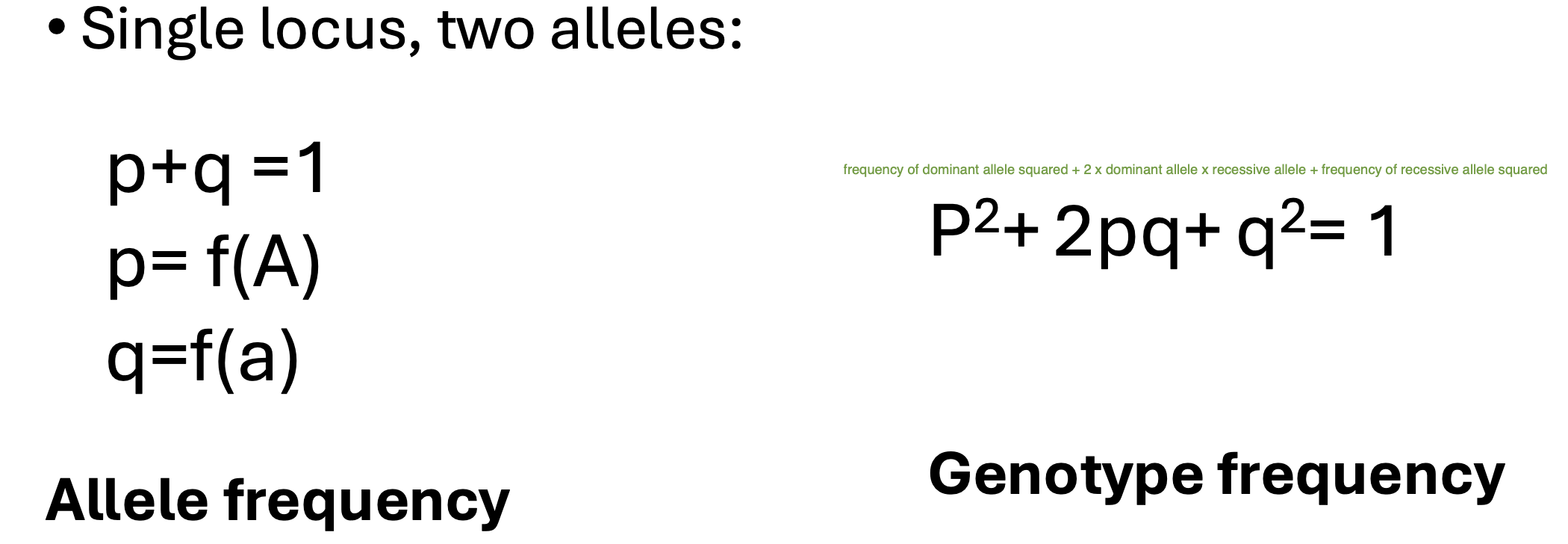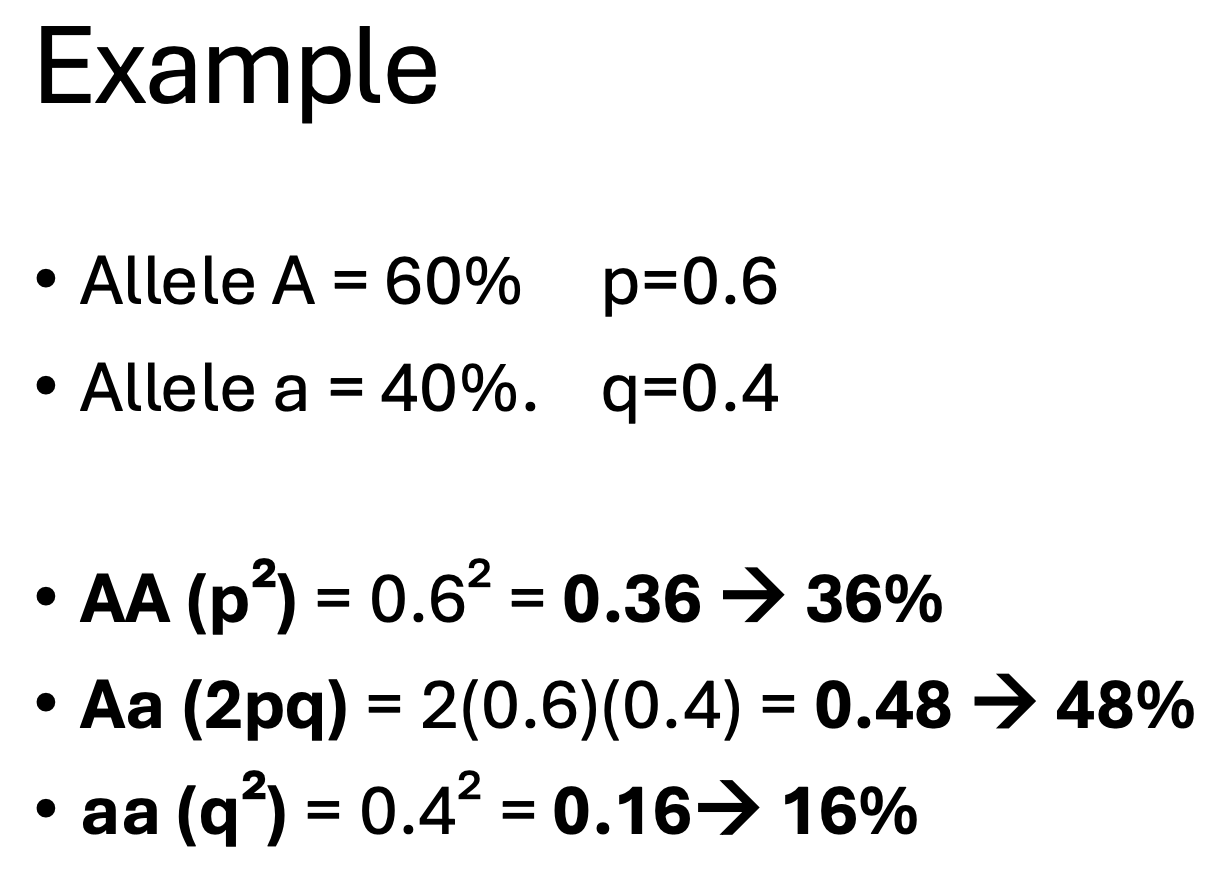Lesson 3 - The Modern Synthesis
1/26
There's no tags or description
Looks like no tags are added yet.
Name | Mastery | Learn | Test | Matching | Spaced |
|---|
No study sessions yet.
27 Terms
What is population genetics (1920s-1930s)? What does it propose? What does it measure?
• Rediscovering Mendel’s work (1900)
Population genetics proposes:
• Evolution as a change in the genetic composition of a population
• Changes in frequency of genotypes in a population — how many genotypes are present given a population (and how many of each)
• Changes in the frequency of alleles in a population
• Mathematical models (quantitative means)
What is the Hardy-Weinberg equilibrium?
• In the absence of evolutionary forces, genotypic frequencies reach equilibrium after one generation (the frequencies of the genotype will remain constant if no evolutionary forces are at play)
One of the mathematical models.
A principle to mathematically quantify the frequency of genotypes (with no evolution present).
Like a null hypothesis (if smg is changing like w natural selection, how are the genotypic frequencies be different).
—> utopic scenario (bc life does not work like this) but it creates a baseline of what would happen to populations if no evolution was happening, which helps see how evolution does make a difference
—> this is a type of base-line/hypothetical, not a theory

What assumptions does the Hardy-Weinberg equilibrium need?
Assumptions:
• No selection
• No mutation
• No migration
• Large population
• Random mating

What is the modern evolutionary synthesis?
• Integrates Darwin’s (evolution) and Mendel’s (heredity) work
—> framework to combine Darwin and Mendel’s work
—> conceptually + experimentally synthesizes the two
—> population genetics is a large part of modern evolutionary synthesis
Who were the founders of the modern evolutionary synthesis?
Sewall Wright (1889-1998)
Ronald A. Fisher (1890-1962)
J.B.S. Haldane ( 1892-1964)
What are 2 types of phenotypic variations?
Continuous
Discontinuous
What are continuous characters?
Traits that may have many different measures (eg height, many variations).
—> A singular trait is impacted by various alleles, and multiple alleles create a bell curve amongst a population (most individuals have an average and then some more exremes)
How do loci affect continuous traits?
—> continuous traits are typically affected by the different loci, and each contributes a little to the trait (if there are two different areas on a chromosome (2 loci) with each two alleles the bell curbe increases. same for 3 loci, you got a wider range and greater number of average/medium genotypes)
—> kinda like an additive expression
—> and this impacts the frequency we observe in intermediate genotypes
What are discontinuous phenotypic variations?
Traits that are either one thing or another (what Mendel worked on, either green OR yellow)
What is phenotypic expression?
• Complex characters are affected by genes at multiple loci (e.g., human height)
• Environmental variation
—> many genes at multiple loci affect height, each adding a little bit of information, and the overall product is the height
—> not only is there a genetic component that we receive from our parents, but also the environment can impact our traits (like height) — eg there is not enough food so you don’t get all the necessary nutrients, so you do not grow as much as you genetically could have
How is phenotypic expression illustrated in the example with the medium ground finches?
Shift in beak depth = increase in + (large) allele frequency.
• After drought found many more alleles with + because after the drought there was a selection for the finches with the deeper beaks (+)
• So now they were more common
• The frequency in alleles with + has shifted, there are more of them after the drought
• This is how you combine darwin and population genetics
• Still a normal distribution, but it has shifted (in this case towards the deeper beaks)
How is variation maintained?
• No blending of genes in sexual reproduction
• Genes are transmitted as intact units
• Blending in expression of genes (genetic materials (genes) do not blend, but rather their expression)
• Hidden variation (these are variations that are not expressed, but they are able to make a comeback in the future if selection/the environment favors them)
What are correlated characters?
• Pleiotropic effects (one gene has effect on multiple different traits (eg one gene might affect both depth and width))
What is an example of correlated characters?
• Beak depth and width
—> correlated response, deeper beaks are usually also wider beaks vs shallower beaks were usually narrower
—> in a situation where selection favors individuals with deeper beaks, after selection there will also have more wide beaks (the two traits go together)
—> both traits are selected, even though only one was advantageous for survival (only deeper beaks were useful for survival, but through it wider beaks were also favored/selected).
What are maladaptive traits?
A characteristic that is, or has become, more harmful than helpful to an organism's ability to survive and reproduce (fitness), contrasting with an adaptation
What is an example of maladaptive traits regarding the medium ground finches?
—> Birds with a thinner beak, in the case of lacking a deep beak, can also be advantageous to reach seeds (but not as much as a deep beak)
—> In this case, a wider beak is a maladaptive trait, but the need for a deep beak is more important + favorable, hence how maladaptive traits can persist
—> Beyond a certain threshold, wide beaks become maladaptive and also die off (so it’s really about a balance between narrower beaks but deeper beaks) — trade off
—> Evolution is all about trade-offs
What are the 4 evolutionary forces of change?
Natural selection
Sexual reproduction
Mutation
Genetic drift
What is genetic drift?
• Chance, not selection (eg you step onto a colony of ants and kill half of them, the half that survived did so by chance, not by genetic favorability)
• Sampling error
• Occurs in all populations
• Stronger effect in small populations
• Reduces variation
• Role in speciation
What are the 2 types of genetic drift?
• Bottleneck
• Founder’s Effect
What is the bottleneck effect?
(like the ant example)
• Population size is reduced
• Variation may decrease
—> smaller sample of surviving individuals are left, next generation is based on this smaller sample of individuals
What is the founder’s effect?
• New colony from a few individuals of an original population
• Less genetic variation than original population
Who were 4 important contributors to the modern synthesis/evolution?
Ernst Mayr
Theodosius Dobzhansky
Ledyard Stebbins
George Gaylord Simpson
What did Ernst Mayr do?
Introduced the idea of the biological concept of the species
What did Theodosius Dobzhansky do?
Famous quote: “Nothing in biology makes sense except in the light of evolution."
What did Ledyard Stebbins do?
Known for applying what we have studied in this lesson and applying it in botany.
What did George Gaylord Simpson do?
Major participant in the modern synthesis and one of the most important paleontologists.
What is the modern synthesis’ legacy?
—> this modern synthesis had a lot of contributions from many different scientists + disciplines
• Provides Darwin's theory with a genetic mechanism
• Reconcile Darwin and Mendel’s approaches
• Unifies multiple fields in biology (Paleontologists, field biologists, and geneticists)
• Provides the foundations of evolutionary biology
• Expansion(s) into today